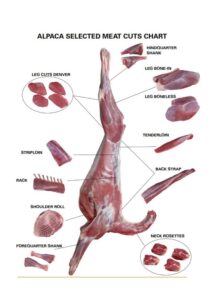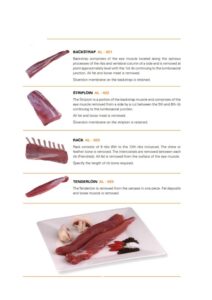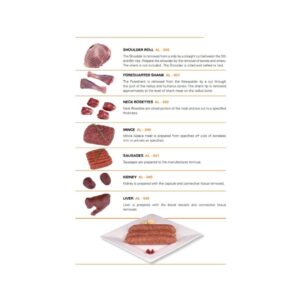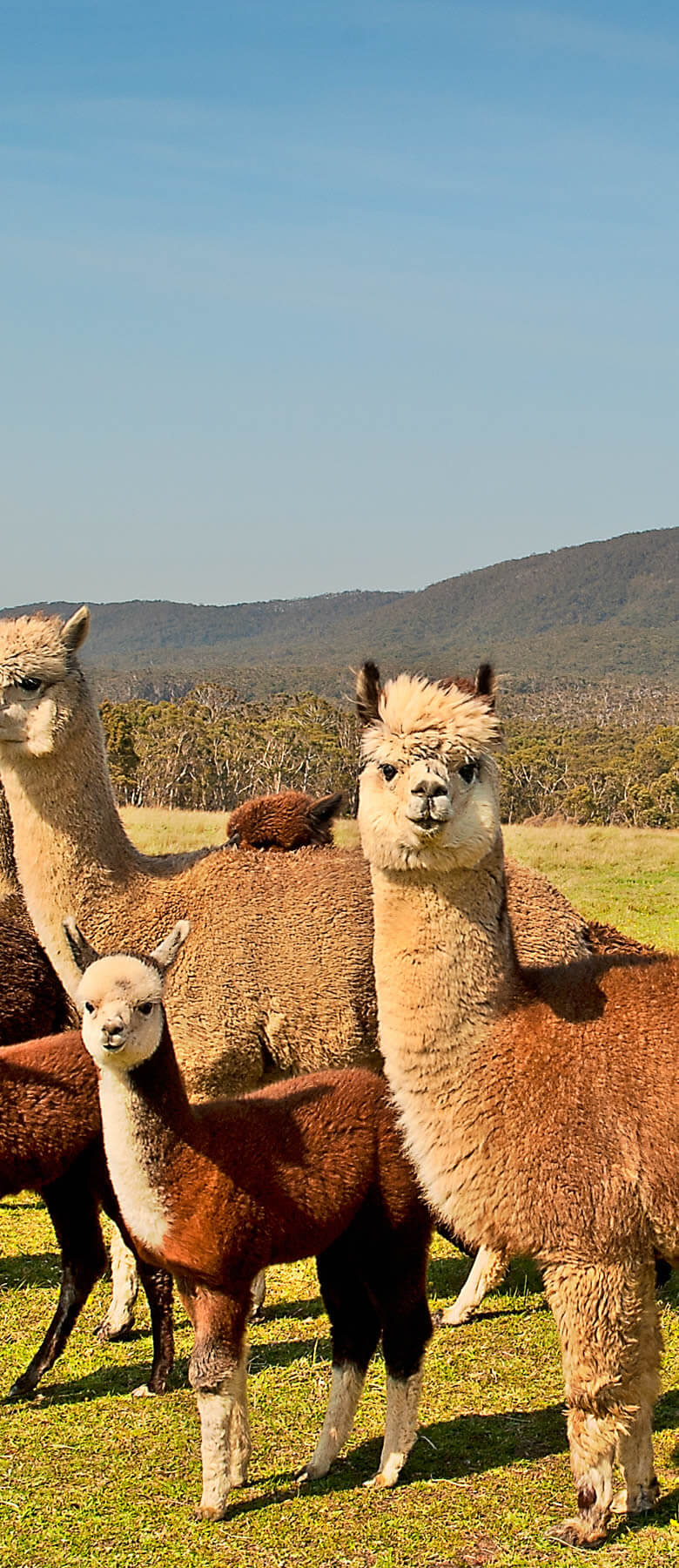Alpaca meat
The commercial farming of alpaca to now include the meat and hide industry has proven that the Australian alpaca industry is now viable in the long term and provides the grower with an additional income stream. The return on capital investment allows existing growers to move on animals they can no longer use in their herd and in return purchase other genetics through matings or new females to improve their herds.
Previously, apart from genetics sought by breeders to bolster their herds from other breeders, there was no defined market or avenue to move on excess animals other than the guardian animals or ‘pets’ on an ad hoc basis. In times of drought and downsizing of sheep herds, these markets can be limited.
Only wethers are sent to market and these can vary in age from 18 months to 60 months. Processors report that so far, there has been no deterioration in quality in age differentiation, but naturally carcase weight will differ. Carcass weight is approximately 58% of live body weight, and each animal must have a body condition score of 2.75 or better.
100% of the animal is used (including offal) from the neck to the shanks. Prime alpaca cuts include strip loin, rump, shoulder roll, back straps and neck rosettes.
Look out for alpaca meat at a restaurant, cafe, winery or deli near you!

Cooking with Alpaca
Alpaca is a mild red meat that is tender, extremely lean, and described by some as almost sweet. Its flavor closest to beef without the fatty aftertaste. Alpaca takes on the flavor of what it’s mixed with making it a chef’s favorite! Alpaca is a high protein, low-fat healthy choice meat. It should be cooked quickly on high heat, turning only once to retain its natural tenderness. For the best results, alpaca should be served rare or medium. After cooking rest on a warmed plate for several minutes before serving.
It goes perfectly with fresh sage, coriander, pine nuts, or chopped garlic.
NUTRITIONAL COMPOSITION OF ALPACA MEAT
(source – RIRDC report 07/172 2007)
Alpaca is a mild red meat that is tender, extremely lean, and described by some as almost sweet. Its flavor closest to beef without the fatty aftertaste. Alpaca takes on the flavor of what it’s mixed with making it a chef’s favorite! Alpaca is a high protein, low-fat healthy choice meat. It should be cooked quickly on high heat, turning only once to retain its natural tenderness. For the best results, alpaca should be served rare or medium. After cooking rest on a warmed plate for several minutes before serving.
It goes perfectly with fresh sage, coriander, pine nuts, or chopped garlic.
NUTRITIONAL COMPOSITION OF ALPACA MEAT
(source – RIRDC report 07/172 2007)
| ALPACA MEAT ANALYSIS | TEST RESULTS |
|---|---|
| Energy – kj/100g | 604 |
| Protein (nx6.25) g /100/g | 23.1 |
| Fat g/100g | 5.7 |
| Fat-Saturated g/1 00g | 3.1 |
| Carbohydrates-Total g /100g | <0.1 |
| Carbohydrates-Sugars g/1 00g | <0.1 |
| Sodium mg/100g | 45 |
| *All analysis was tested on Alpaca Backstrap | |
Alpaca Recipes
Matt Moran’s Alpaca Curry
Source: Lifestyle Food
Ingredients
Alejandro Saravia’s Huanta style alpaca shoulder
source: SBS Food
Ingredients
- 1 alpaca shoulder
- quinoa, to serve
- 2 potatoes, scrubbed and sliced
- 1 brown onion, halved and sliced
Brine
- 500 g white sugar
- 500 g table salt
- 5 litres water
- 2 cinnamon sticks
- 2 star anise
- 1 tsp cumin seeds
- 2 fresh bay leaves
Huanta paste
- 3 dried aji panca chillies, stalks trimmed
- 3 dried aji mirasol chillies, stalks trimmed
- 1 onion, chopped
- 500 ml(2 cups) olive oil
- 2 garlic cloves
Instructions
Standing time 4 hours
To make the brine, place the sugar, salt and water in a large saucepan and whisk vigorously until sugar and salt dissolve. Bring to the boil, then remove from the heat. Add the spices and bay leaves and cool to room temperature. Add the alpaca to brine and stand for 4 hours.
To make the huanta paste, blanch the chillies in boiling water for 3 minutes. Drain and set aside. Place the olive oil and garlic cloves in a saucepan over low heat and cook for 5 minutes. Remove from the heat, add the onion and stand for 10 minutes. Place chillies and olive oil mixture in a blender and process until smooth paste forms.
Preheat the oven to 180°C. Line a large baking tray with baking paper. Spread the potatoes and onion evenly over the tray. Drain alpaca and pat dry. Thickly brush all over with huanta paste. Place on top of vegetables.
Cover tray with foil and cook for 3–4 hours, or until meat falls off the bone.
Italian Meatballs
With thanks to Felicia Hyde, Tallarook Meat Co
500g Alpaca Mince
2 slices white bread, crusts removed and torn
½ cup of milk
1 medium onion, grated
1 egg, lightly beaten
1/3 cup finely chopped basil leaves
1/3 cup finely chopped parsley
1/3 cup fresh grated parmesan cheese
2 tablespoon olive oil
500g jar tomato pasta sauce
Method:
Place bread in a large bowl, add milk and let stand for 5 minutes or until milk is absorbed.
Add mince, onion, egg, basil, parsley, and cheese, season with salt and pepper.
Mix to combine.
Roll level tablespoons of mixture into balls and place on a plate.
Heat oil in in a large frying pan, over a medium heat.
Add meatballs and cook, turning, until brown and cooked through.
Add pasta sauce, bring to boil. Reduce heat to low and simmer for 5 minutes.
Serve with pasta of choice.
Sicilian Alpaca Pot Roast
With thanks to Felicia Hyde, Tallarook Meat Co
750g Alpaca shoulder chops, cut each chop in 4 pieces (or 750g alpaca neck rosettes).
1 tsp olive oil
1 brown onion, thinly sliced
2 carrots, sliced
2 celery stalks, chopped
2 cloves garlic, thinly sliced
½ cup dry white wine
1 x 400g can diced tomatoes
45g anchovies
1 cinnamon stick
½ cup currants
½ cup black olives (pitted)
2 tblsp pine nuts
Continental parsley for garnish
Season alpaca with salt and pepper.
Brown lightly in a hot pan and place in slow cooker pot.
Using the same pan, add onion, celery, carrot and garlic. Cook until onion is soft. Add to the slow cooker pot.
Deglaze pan with wine and add to pot.
Add tomatoes, anchovies, chilli, currants, and cinnamon to pot.
Cook in the slow cooker on low for 8-12 hours.
Top with olives, pine nuts and parsley prior to serving.
Serve with couscous.
Serves 4
Adapted from: Super Food Ideas Magazine Aug 2013
Alpaca steak with purple congo potato, corn and chilli salad
source – Australian House and Garden
8 medium purple congo potatoes, washed
3 cobs sweetcorn
1tsp dried sage
1tsp dried parsley
1 tsp dried basil
1tsp dried oregano
2tbsp salt
800g alpaca fillet, trimmed and cut into 4 x 200g pieces
2 tbsp vegetable oil
2 fresh small chillies, thinly slices
1 bunch fresh chives, cut into batons
1/3 cup EV olive oil
1 1/2 tbsp white wine vinegar
Steam potatoes until just cooked through. Allow to cool to room temp and cut into small pieces
Preheat BBQ to high heat and cook corn on each side until charred. Remove kernels from cobs
Combined dried herbs and salt in a bowl and coat meat in herb and salt mix. Heat BBQ to high heat and add vegetable oil. Sear fillets on all sides until golden, remove from pan and rest in a warm place for 10 minutes
Arrange potatoes and corn on a large serving plate and season with salt pepper, top with chilli and chives. Combine oil and vinegar in a small jug and drizzle over salad.
Serve with sliced meat.
Alpaca Carcase and Cuts Guide
Alpaca Carcase Chart

source – RIRDC Publication 07/172
Alpaca meat products (1)

source – RIRDC Publication 07/172
Alpaca meat products (2)

source – RIRDC Publication 07/172
Alpaca meat products (3)

source – RIRDC Publication 07/172


